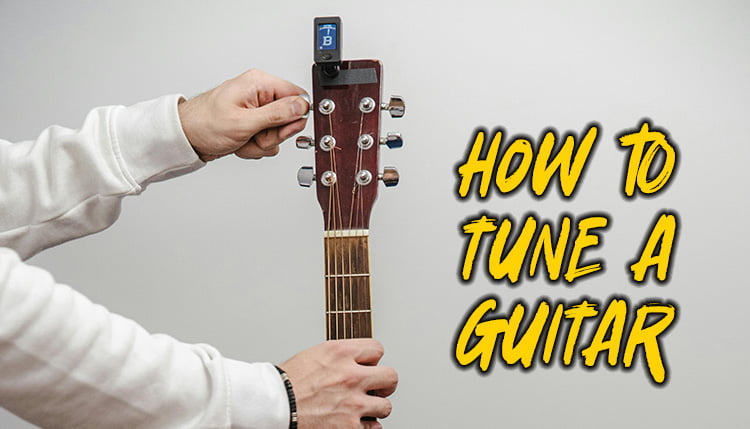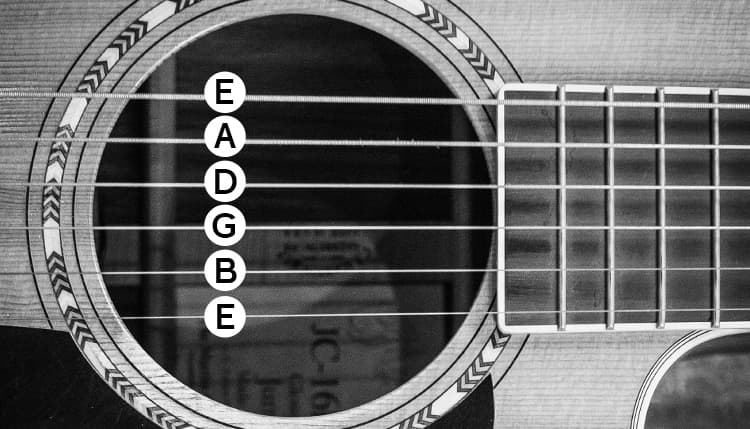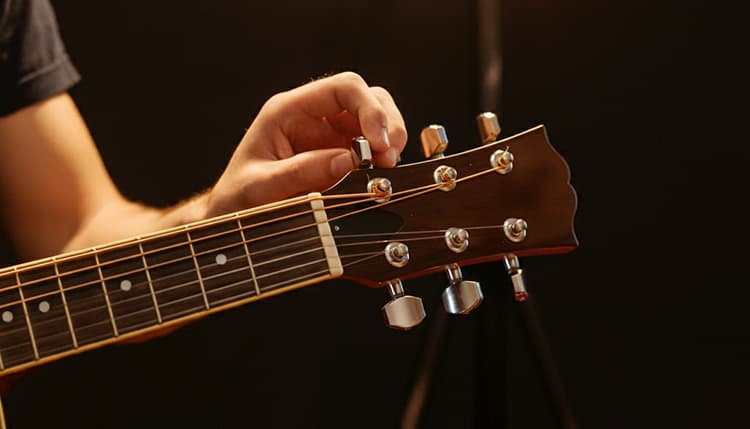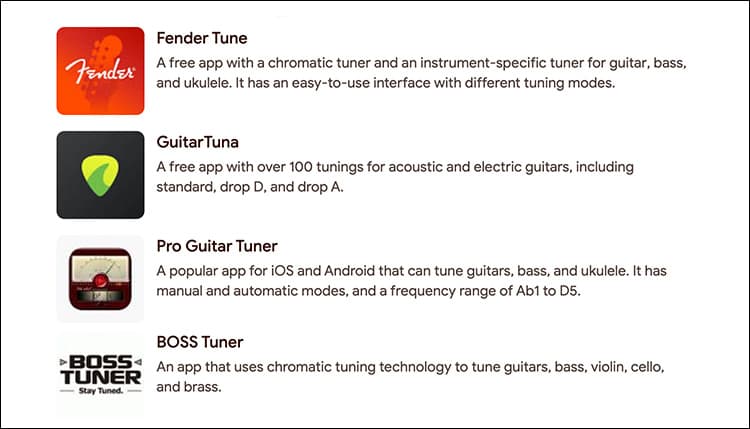Tuning Your Guitar
Getting your guitar in tune is like giving it a little mood boost. Making sure your instrument sounds its best, all starts with a good tune-up, whether you’re just starting out or have been jamming for years. So let’s learn how to tune a guitar.
Importance of Guitar Tuning
Let’s face it, nobody wants to hear a guitar that sounds off. Tuning isn’t just about getting the right notes—it turns your playing into music that’s easy on the ears.
Think of it as the glue that holds your tunes together. When your guitar isn’t in tune, it can sound a bit like a cat fight: loud and unpleasant.
Regular tuning also does wonders for the health of your guitar. Keeping those strings at just the right tension keeps everything in tip-top shape, preventing any wobbles or warps in the neck and body over time.
Plus, whether you’re having a jam session with a band or following along with your favorite tracks, being in tune means you’re right there in harmony.
Basics of How to Tune a Guitar
Getting the basics down is pretty simple. Start with the standard way people tune their guitars, aiming for the notes of E, A, D, G, B, and E, from low to high.
It’s like a little musical scale all on its own and happens to be the go-to because it feels natural under your fingers.
| String Number | Note |
|---|---|
| 1 (thinnest) | E |
| 2 | B |
| 3 | G |
| 4 | D |
| 5 | A |
| 6 (thickest) | E |
When learning how to tune a guitar, you’ve got some options: try an electronic tuner, a tuning app, stick with your ear, or whip out some harmonics.
So you went out and bought the best beginner guitar and you’re learning how to play guitar, well grabbing an electronic tuner is usually a smart move—it kinda makes things foolproof.
Anyway, the general idea is to pluck, twist, and tweak until each string rings out clear as a bell at just the spot you want it.
Understanding the little jumps and skips between the strings—like how the notes between the 5th string (A) and the 6th string (E) harmonize perfectly—really makes each note click into place.
Once you nail the basics, you’re on track for sounds that’ll make you grin ear to ear every time you pick up your guitar.
Standard Guitar Tuning
To make sure our guitar sings like a dream, we’ve got to get the tuning spot-on.
Standard tuning is where most of us start—it’s the go-to for beginners and old hands alike.
String Notes in Standard Tuning
On to the nitty-gritty: those string notes! The guitar has six strings jam packed with tunes, from low to high. Check out this chart:
| String Number | String Note |
|---|---|
| 6th (Bottom) | E |
| 5th | A |
| 4th | D |
| 3rd | G |
| 2nd | B |
| 1st (Top) | E |
This popular setup, called EADGBE, fits both classical and acoustic guitars like a glove.
Tuning to Standard EADGBE
Getting your strings to EADGBE doesn’t have to be a hair-puller.
Here’s a simple-as-pie method on how to tune the guitar strings one by one:
- Low E String (6th String): Kick things off with the low E. You can use a snazzy electronic tuner or match it with a piano or a tuning fork.
- A String (5th String): With low E in the groove, press the low E at the 5th fret to find an A note. Get your open A string (5th string) jiving with it.
- D String (4th String): Onwards to the 5th fret of the A string for a D note. Tune the open D string (4th string) to this pitch.
- G String (3rd String): Hit the 5th fret of the D string to pull off a G note. Match the open G string (3rd string) to it.
- B String (2nd String): For the B string, dab your finger on the 4th fret of the G string to get a B note. Tune that open B string (2nd string) till it fits right in.
- High E String (1st String): At last, press the 5th fret of the B string (2nd string) to get another E note. Tweak the open high E string (1st string) to make it sing.
| Step | Action |
|---|---|
| 1 | Tweak Low E String using an electronic tuner or a reference note |
| 2 | Tap 5th fret of Low E to tune the open A String |
| 3 | Tap 5th fret of A String to tune the open D String |
| 4 | Tap 5th fret of D String to tune the open G String |
| 5 | Tap 4th fret of G String to tune the open B String |
| 6 | Tap 5th fret of B String to tune the open High E String |
Memory lane is your friend! Try tricks like “Eddie Ate Dynamite, Good Bye Eddie” or even “Eat A Dead Grasshopper Before Everything” to nail down those notes.
Following this game plan gets our guitar vibe-ready for the jam ahead.
Alternate Guitar Tunings
Messing around with alternate guitar tunings can totally shake up your sound and unlock fresh grooves.
Let’s jump into some well-known ones: Open C, Open G, Drop D, and DADGAD.
Open C Tuning
Open C tuning is like magic for creating a C chord when you rock those open strings, a go-to for folks like Coldplay and Bon Iver.
It vibes nicely with acoustic guitars and fingerstyle jamming. Here’s the lowdown on how to tune a guitar in Open C:
| String | Note |
|---|---|
| 6th (low) | C |
| 5th | G |
| 4th | C |
| 3rd | G |
| 2nd | C |
| 1st (high) | E |
Open G Tuning
Ever wondered how to tune a guitar like The Rolling Stones and get that classic rock sound? It’s Open G tuning.
Strum open strings, and you’ve got a G chord right there. Set up your guitar like this:
| String | Note |
|---|---|
| 6th (low) | D |
| 5th | G |
| 4th | D |
| 3rd | G |
| 2nd | B |
| 1st (high) | D |
This one’s steeped in blues vibes, loved by legends like Robert Johnson and Joni Mitchell.
Drop D Tuning
Drop D tuning is as easy as dropping that low E to a D. Simple tweak, big impact! Adds a heavy blues, rock, or grunge flair.
Check how to tune a guitar like Nirvana and Metallica:
| String | Note |
|---|---|
| 6th (low) | D |
| 5th | A |
| 4th | D |
| 3rd | G |
| 2nd | B |
| 1st (high) | E |
DADGAD Tuning
DADGAD is your ticket for cheerful and intricate sounds, perfect for Celtic vibes and finger style magic.
This is how to tune a guitar like Ed Sheeran and Led Zeppelin. Try it:
| String | Note |
|---|---|
| 6th (low) | D |
| 5th | A |
| 4th | D |
| 3rd | G |
| 2nd | A |
| 1st (high) | D |
Rock any of these tunings to give your music a fresh twist and spark some new ideas. Go ahead, experiment and see where it takes you!
Methods for How to Tune a Guitar
We’ve got more ways to tune a guitar than strings on the darn thing, and each brings its own perks to the table.
We’ll talk about four trusty friends: the electronic tuner, tuning by ear, harmonics, and taking cues from the keyboard.
Tuning with Electronic Tuners
Electronic tuners or guitar pedals are like having a musical GPS; they make it easy and precise. The tuner listens to each string and tells you if it’s sharp, flat, or spot on. Here’s how to work it:
- Flick that tuner on and set it to guitar mode.
- Strum the string you’re working on.
- Twist the tuning peg based on what the tuner says. If the light’s to the left, the string’s flat. Right, and it’s sharp.
These handy gadgets are perfect for newbies—they’re straightforward and get the job done right.
How to Tune a Guitar Without a Tuner (By Ear)
Tuning by ear can feel like learning to whistle—it’s tricky at first but totally worth it. Here’s a simple way to get started:
- Get the low E string in line with a piano or tuning fork.
- Press down on the 5th fret of the E string and pluck it with the open A string. Adjust until they’re twins.
- Do the same for the rest of the strings, using these frets:
- 5th fret on 5th string to open 4th string.
- 5th fret on 4th string to open 3rd string.
- 4th fret on 3rd string to open 2nd string.
- 5th fret on 2nd string to open 1st string.
Give it some time and practice, and you’ll tune like a pro.
Tuning with Harmonics
Harmonics can make tuning a cinch, especially when you need both hands free. Here’s your quick guide:
- Gently touch the string at the 5th fret and pluck to hear a harmonic.
- Compare it to the harmonic on the 7th fret of the next string up.
- Fiddle with the tuning peg until they match.
It’s a handy way to get strings in sync with each other, perfect for solo practice.
Tuning from the Keyboard
When jamming with others, having all instruments in sync is crucial. Here’s how to keep your guitar in tune with a keyboard:
Line up each string’s note with the keyboard’s keys.
Like this:
- The low E string goes with the E key.
- A string lines up with the A key.
- D string pairs with the D key.
- G string fits with the G key.
- B string syncs with the B key.
- High E string matches high E key.
Some fancy tuners let you switch them to match the keyboard, making sure everyone keeps in harmony.
By trying out these methods, your guitar won’t just be in tune, it’ll sing right along with you, making your musical adventures all the more harmonious.
Tips for Effective Tuning
Keeping our guitar sounding sweet and pitch-perfect isn’t all about twisting the pegs just right. It’s about getting to grips with how to keep it tuned and sounding fine. Here are some handy tricks and tips on how to tune a guitar.
Using Tuning Apps
Thanks to modern tech, learning how to tune a guitar has become ridiculously easy. Who needs a fancy tuner when we can just use our phones?
There are heaps of apps that use our phone’s mic to catch the sound of each string, showing us if we’re sharp or flat.
And here’s the best part—most of them won’t cost a dime! Whether we’re just getting started or have been strumming for years, these apps make tuning a walk in the park.
Here are a few to check out:
Memorizing String Notes
Knowing the notes of each string by heart saves time and makes tuning a snap. Here they are: E, A, D, G, B, E.
Remembering these notes might sound like homework, but we’ve got a couple of silly sentences to help us out:
- Eddie Ate Dynamite, Good Bye Eddie
- Eat A Dead Grasshopper Before Everything
| String Number | Note |
|---|---|
| 1 (thinnest) | E |
| 2 | B |
| 3 | G |
| 4 | D |
| 5 | A |
| 6 (thickest) | E |
Maintaining Proper Tuning
Got our guitar in tune? Nice job! Now let’s keep it there:
- Check tuning regularly, especially before jam sessions or gigs.
- Steer clear of hot and cold. Strings don’t dig temperature swings.
- Change those old strings—they’re slackers when it comes to holding pitch.
- Stash the guitar in a spot that keeps it safe and sound.
- Get a trusty tuner for spot-on tuning.
Importance of String Spacing
Even gaps between strings are a big deal for strumming with precision. If one string is out of line, we’re fighting a losing battle to stay in tune.
Making sure the bridge and nut are perfectly set makes all the difference and keeps our guitar sounding ace.
Now you know how to tune a guitar and with these tricks up our sleeve, we’re ready to make some magic.
Let’s keep it in tune and enjoy making music! Happy tuning!











